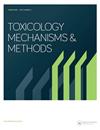The effects of changes in glutathione levels through exogenous agents on intracellular cysteine content and protein adduct formation in chronic alcohol-treated VL17A cells
IF 2.8
4区 医学
Q2 TOXICOLOGY
引用次数: 3
Abstract
Abstract Alcohol-mediated liver injury is associated with changes in the level of the major cellular antioxidant glutathione (GSH). It is interesting to investigate if the changes in intracellular GSH level through exogenous agents affect the intracellular cysteine content and the protein adduct formation indicative of oxidative insult in chronic alcohol treated liver cells. In VL-17A cells treated with 2 mM N-acetyl cysteine (NAC) or 0.1 mM ursodeoxycholic acid (UDCA) plus 100 mM ethanol, an increase in cysteine concentration which was accompanied by decreases in hydroxynonenal (HNE) and glutathionylated protein adducts were observed. Pretreatment of 100 mM ethanol treated VL-17A cells with 0.4 mM buthionine sulfoximine (BSO) or 1 mM diethyl maleate (DEM) had opposite effects. Thus, altered GSH level through exogenous agents may either potentiate or ameliorate chronic alcohol-mediated protein adduct formation and change the cysteine level in chronic alcohol treated VL-17A cells. The gene expression of non-treated and ethanol-treated hepatocytes in 2 microarray datasets was also compared to locate differentially expressed genes involved in cysteine metabolism. The study demonstrates that increased protein adducts formation and changes in cysteine concentration occur under chronic alcohol condition in liver cells which may increase alcohol-mediated oxidative injury.外源性谷胱甘肽水平变化对慢性酒精处理的VL17A细胞内半胱氨酸含量和蛋白质加合物形成的影响
酒精介导的肝损伤与主要细胞抗氧化剂谷胱甘肽(GSH)水平的变化有关。在慢性酒精处理的肝细胞中,通过外源性药物改变细胞内GSH水平是否会影响细胞内半胱氨酸含量和指示氧化损伤的蛋白质加合物形成,这是一个有趣的研究。在2 mM n -乙酰半胱氨酸(NAC)或0.1 mM熊去氧胆酸(UDCA)加100 mM乙醇处理的VL-17A细胞中,观察到半胱氨酸浓度增加,同时羟基壬烯醛(HNE)和谷胱甘肽化蛋白加合物减少。用0.4 mM丁硫氨酸亚砜(BSO)或1 mM马来酸二乙酯(DEM)对100 mM乙醇处理的VL-17A细胞进行预处理,效果相反。因此,外源性药物改变的谷胱甘肽水平可能增强或改善慢性酒精介导的蛋白质加合物形成,并改变慢性酒精处理的VL-17A细胞的半胱氨酸水平。还比较了2个微阵列数据集中未处理和乙醇处理的肝细胞的基因表达,以定位参与半胱氨酸代谢的差异表达基因。研究表明,在慢性酒精状态下,肝细胞中蛋白质加合物的形成增加和半胱氨酸浓度的变化可能会增加酒精介导的氧化损伤。
本文章由计算机程序翻译,如有差异,请以英文原文为准。
求助全文
约1分钟内获得全文
求助全文
来源期刊

Toxicology Mechanisms and Methods
TOXICOLOGY-
自引率
3.10%
发文量
66
期刊介绍:
Toxicology Mechanisms and Methods is a peer-reviewed journal whose aim is twofold. Firstly, the journal contains original research on subjects dealing with the mechanisms by which foreign chemicals cause toxic tissue injury. Chemical substances of interest include industrial compounds, environmental pollutants, hazardous wastes, drugs, pesticides, and chemical warfare agents. The scope of the journal spans from molecular and cellular mechanisms of action to the consideration of mechanistic evidence in establishing regulatory policy.
Secondly, the journal addresses aspects of the development, validation, and application of new and existing laboratory methods, techniques, and equipment. A variety of research methods are discussed, including:
In vivo studies with standard and alternative species
In vitro studies and alternative methodologies
Molecular, biochemical, and cellular techniques
Pharmacokinetics and pharmacodynamics
Mathematical modeling and computer programs
Forensic analyses
Risk assessment
Data collection and analysis.
 求助内容:
求助内容: 应助结果提醒方式:
应助结果提醒方式:


